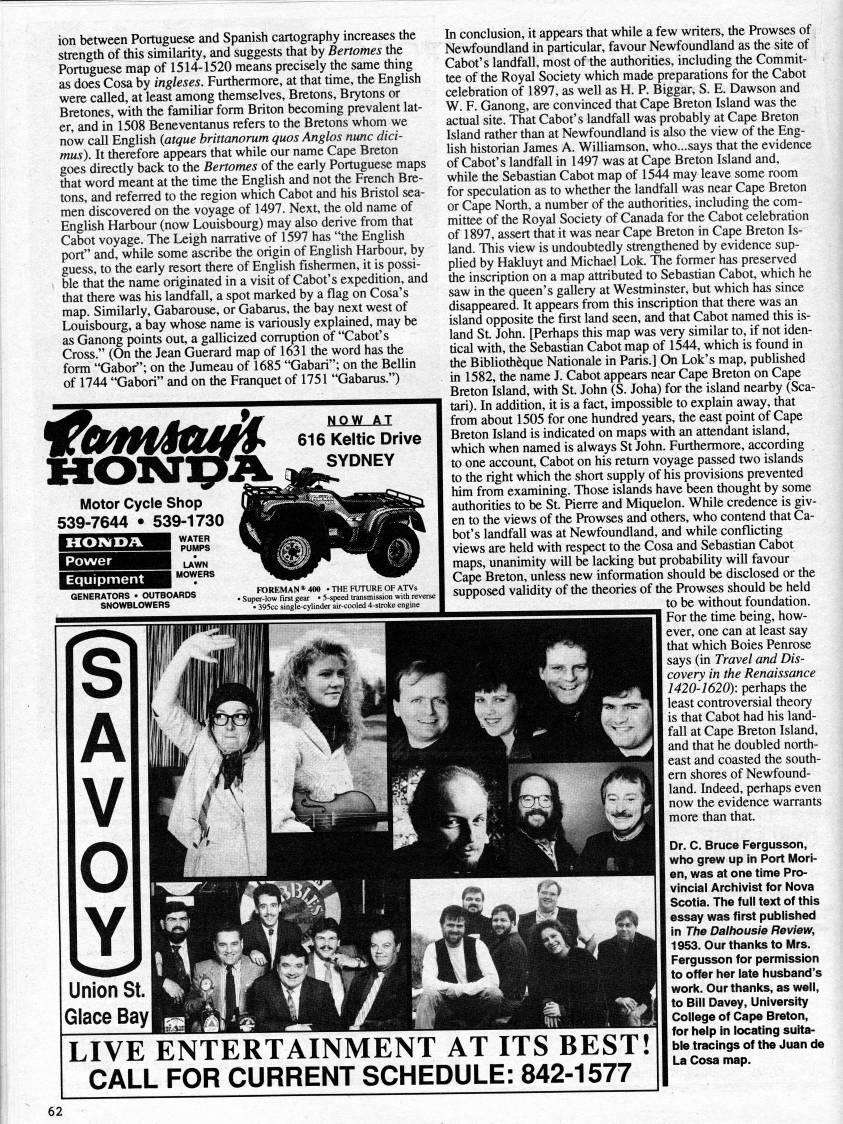Page 62 - John Cabot's Landfall, 1497 - "It WAS Cape Breton!"
Published by Ronald Caplan on 1996/6/1 (256 reads)
 Page 61 - John Cabot's Landfall, 1497 - "It WAS Cape Breton!"
Page 61 - John Cabot's Landfall, 1497 - "It WAS Cape Breton!"
Page 63 - Joe Nugent, Inspector of Mines, Ret'd

ion between Portuguese and Spanish cartography increases the strength of this similarity, and suggests that by Bertomes the Portuguese map of 1514-1520 means precisely the same thing as does Cosa by ingleses. Furthermore, at that time, the English were called, at least among themselves, Bretons, Brytons or Bretones, with the familiar form Briton becoming prevalent lat? er, and in 1508 Beneventanus refers to the Bretons whom we now call English (atque brittanorum quos Anglos nunc dici- mus). It therefore appears that while our name Cape Breton goes directly back to the Bertomes of the early Portuguese maps tiiat word meant at the time the English and not the French Bre? tons, and referred to the region which Cabot and his Bristol sea? men discovered on the voyage of 1497. Next, the old name of English Harbour (now Louisbourg) may also derive from that Cabot voyage. The Leigh narrative of 1597 has "the English port" and, while some ascribe the origin of English Harbour, by guess, to the early resort there of English fishermen, it is possi? ble that the name originated in a visit of Cabot's expedition, and that there was his landfall, a spot marked by a flag on Cosa's map. Similarly, Gabarouse, or Gabarus, the bay next west of Louisbourg, a bay whose name is variously explained, may be as Ganong points out, a gallicized corruption of "Cabot's Cross." (On the Jean Guerard map of 1631 the word has the form "Gabor"; on the Jumeau of 1685 "Gabari"; on the Bellin of 1744 "Gabori" and on the Franquet of 1751 "Gabarus.") NOW AT 616 Keltic Drive SYDNEY Motor Cycle Shop 539-7644 • 539-1730 HOMTDAl Equipment FOREMAN* 400 • THE FUTURE OF ATVs • Super-low first gear • 5-speed transmission with revei • 395cc single-cylinder air-cooled 4-stroke engine LIVE ENTERTAINMENT AT ITS BEST! CALL FOR CURRENT SCHEDULE: 842-1577 In conclusion, it appears that while a few writers, the Prowses of Newfoundland in particular, favour Newfoundland as the site of Cabot's landfall, most of the authorities, including the Commit? tee of the Royal Society which made preparations for the Cabot celebration of 1897, as well as H. P. Biggar, S. E. Dawson and W. F. Ganong, are convinced that Cape Breton Island was the actual site. That Cabot's landfall was probably at Cape Breton Island rather than at Newfoundland is also the view of the Eng- Ush historian James A. Williamson, who...says that the evidence of Cabot's landfall in 1497 was at Cape Breton Island and, while the Sebastian Cabot map of 1544 may leave some room for speculation as to whether the landfall was near Cape Breton or Cape North, a number of the authorities, including the com? mittee of the Royal Society of Canada for the Cabot celebration of 1897, assert that it was near Cape Breton in Cape Breton Is? land. This view is undoubtedly strengthened by evidence sup? plied by Hakluyt and Michael Lok. The former has preserved the inscription on a map attributed to Sebastian Cabot, which he saw in the queen's gallery at Westminster, but which has since disappeared. It appears from this inscription that there was an island opposite the first land seen, and that Cabot named this is? land St. John. [Perhaps this map was very similar to, if not iden? tical with, the Sebastian Cabot map of 1544, which is found in the Bibliotheque Nationale in Paris.] On Lok's map, published in 1582, the name J. Cabot appears near Cape Breton on Cape Breton Island, with St. John (S. Joha) for the island nearby (Sca? tari). In addition, it is a fact, impossible to explain away, that from about 1505 for one hundred years, the east point of Cape Breton Island is indicated on maps with an attendant island, which when named is always St John. Furthermore, according to one account, Cabot on his retum voyage passed two islands to the right which the short supply of his provisions prevented him from examining. Those islands have been thought by some authorities to be St. Pierre and Miquelon. While credence is giv? en to the views of the Prowses and others, who contend that Ca? bot's landfall was at Newfoundland, and while conflicting views are held with respect to the Cosa and Sebastian Cabot maps, unanimity will be lacking but probability will favour Cape Breton, unless new information should be disclosed or the supposed validity of the theories of the Prowses should be held to be without foundation. For the time being, how? ever, one can at least say that which Boies Penrose says (in Travel and Dis? covery in the Renaissance 1420-1620): perhaps the least controversial theory is that Cabot had his land? fall at Cape Breton Island, and that he doubled north? east and coasted the south- em shores of Newfound? land. Indeed, perhaps even now the evidence warrants more than that. Dr. C. Bruce Fergusson, who grew up in Port Mori? en, was at one time Pro? vincial Archivist for Nova Scotia. The full text of this essay was first published in The Dalhousie Review, 1953. Our thanlis to iVIrs. Fergusson for permission to offer her late husband's worl(. Our thanlcs, as well, to Bill Davey, University College of Cape Breton, for help in locating suita? ble tracings of the Juan de La Cosa map.
 Page 61 - John Cabot's Landfall, 1497 - "It WAS Cape Breton!"
Page 61 - John Cabot's Landfall, 1497 - "It WAS Cape Breton!"
Page 63 - Joe Nugent, Inspector of Mines, Ret'd

Adobe Acrobat Reader is required to the PDF version of this content. Click here to download and install the Acrobat plugin



